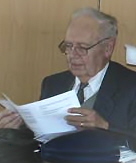Challenging Special Relativity: A New Train Paradox
Year: 2006 Pages: 2
Keywords: light velocity, special relativity, Lorentz-transformation
Velocity is defined as distance traveled per time, hence c = x/t. The dilation of time in special relativity is given by the factor: t' = t / (1 - v?/c?)1/2.
Moreover, due to the Lorentz-contraction x' = x / (1 - v?/c?)1/2 as well. Calculating space and time for c' = x'/t', either stretching factor in the numerator and the denominator cancel out.
This leads to a paradox: If the velocity of light is constant in any system, i.e. if c' = c , clocks will have to alter their pace due to the linear term for time in the Lorentz-transformation depending on the direction of motion.
Let us in this paper now consider a train passing by a shining lantern at rest and let an observer in the train wish to measure the velocity of light before and after he train had passed by the source of light. We see that the same clock is ticking slower when the light is in front and ticking faster when the light is behind.


